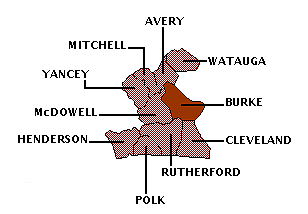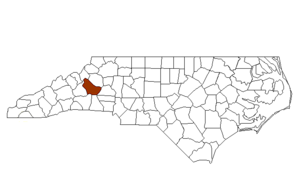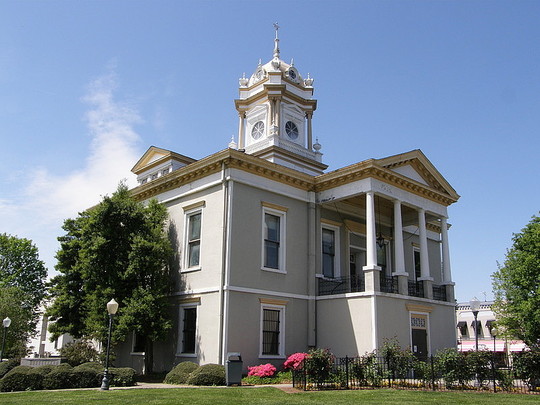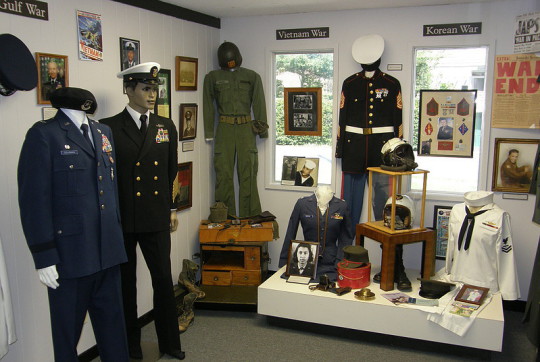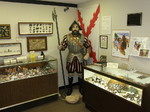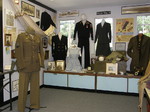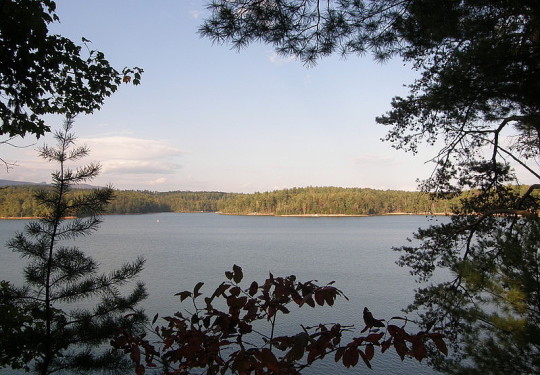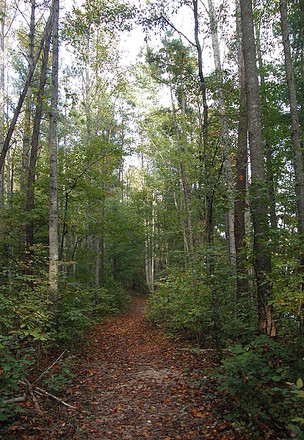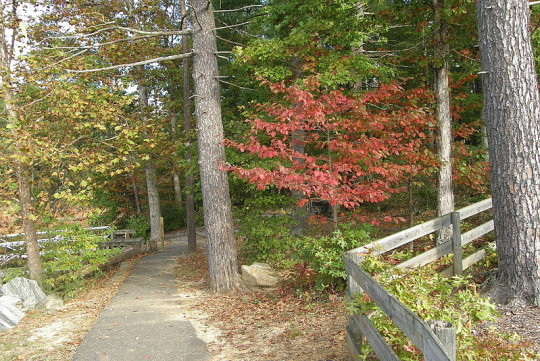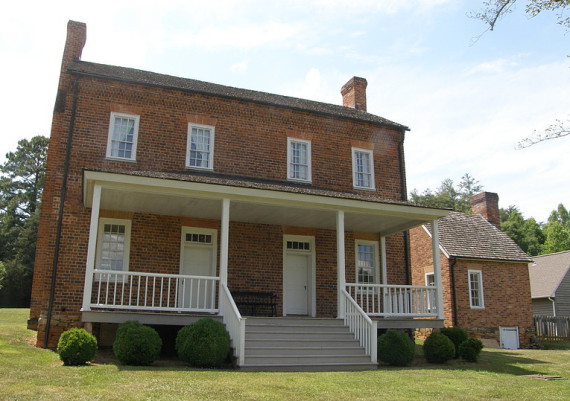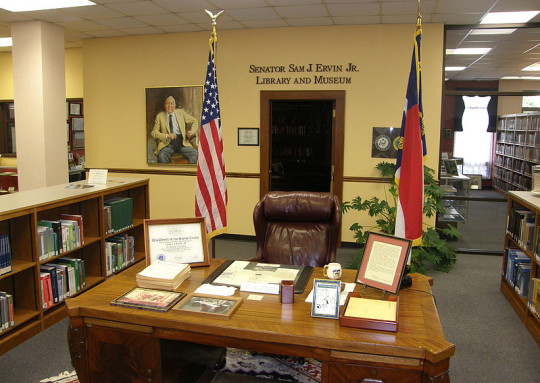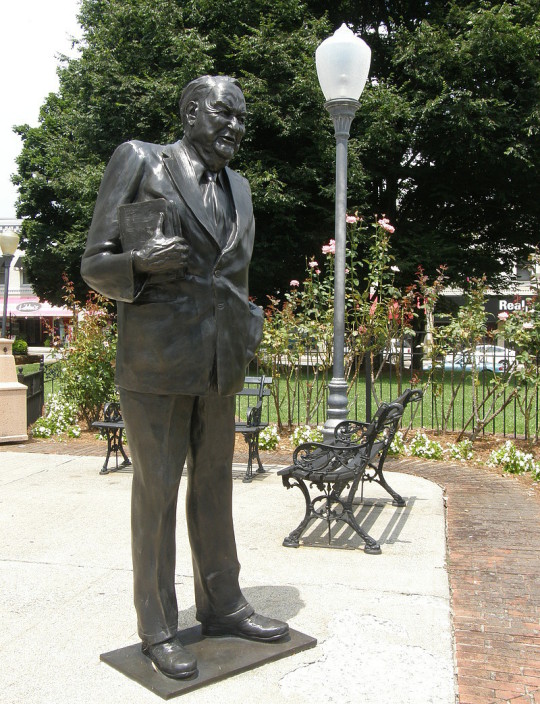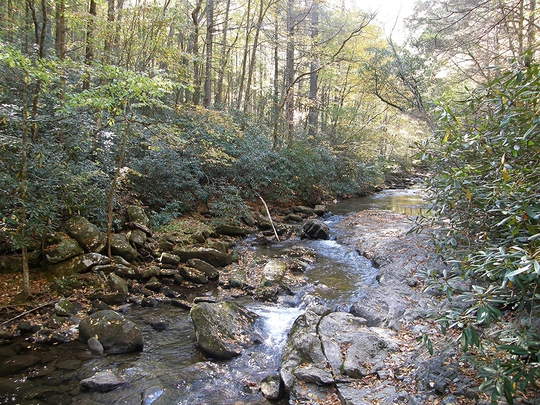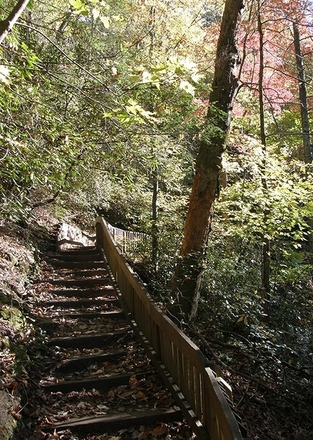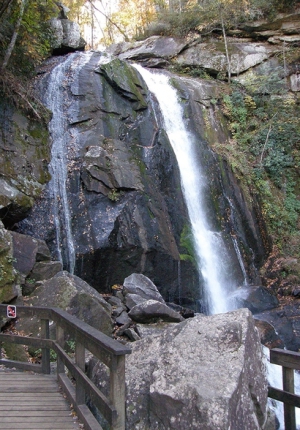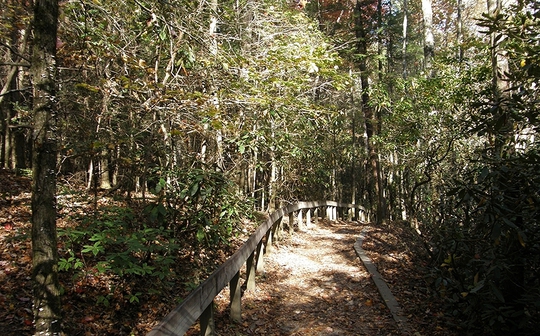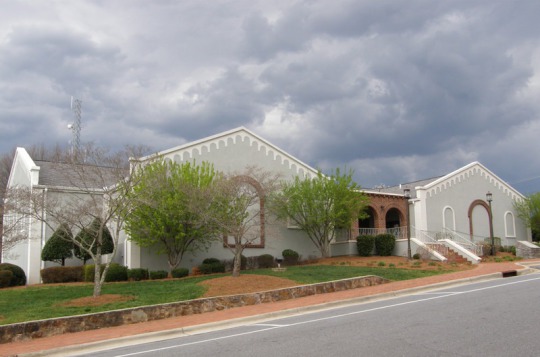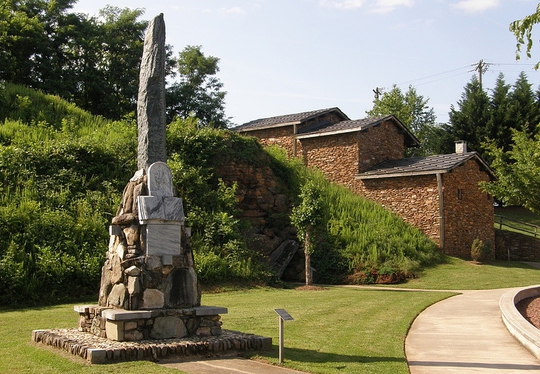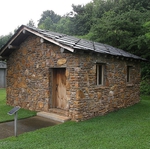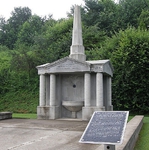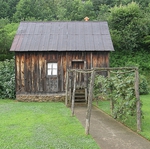BURKE COUNTY
Scroll down this page or click on specific site name to view features on the following Burke County attractions/points of interest:
History Museum of Burke County, Lake James State Park, Morganton Railroad Museum, Quaker Meadows, Sam Ervin Library and Museum, South Mountains State Park, Waldensian Heritage Museum, Waldensian Trail of Faith
Fast facts about Burke County:
Created in 1777, the county is named for Thomas Burke, a Revolutionary patriot, a delegate to the Continental Congress, and a North Carolina governor.
The county seat is Morganton, named for Revolutionary War general Daniel Morgan.
Burke County’s land area is 506.72 square miles; the population in the 2010 census was 90,912.
It is worth noting that Lake James State Park, South Mountains State Park, and a portion of the Pisgah National Forest are all located in Burke County.
Below: The former Burke County Courthouse in Morganton
Morganton
In its first decade of existence, the History Museum of Burke County has gathered together an impressive assortment of mostly ordinary, sometimes exceptional, artifacts from generations past, all displayed to good effect in a spacious, 1960s-era building originally used as Morganton’s City Hall. Appropriately, portraits of Thomas Burke and Daniel Morgan, for whom the county and city were named, are found in the lobby. Visitors are given guided tours through the many exhibit rooms, some of which recreate such everyday settings from the mid-20th century as the Burkemont Hotel’s barber shop, Vivian’s Beauty Shop, Dave’s Café, and the generic offices of a doctor and a dentist. Other rooms present generic themed collections: military artifacts, children’s toys and games, farm implements, and so on. A few rooms are very specific to Burke County, such as the one displaying 1930s-era bedroom furniture manufactured in nearby Drexel, or the one detailing explorer Juan Pardo’s efforts at Spanish colonization in the vicinity of Morganton in 1567, nearly two decades before an English colony was attempted on Roanoke Island. One exhibit is devoted to telling the sad story of Frankie Silver, who was tried, found guilty, and hung for the murder -- and subsequent dismemberment -- of her husband Charlie.
The Museum also oversees the recently restored Morganton Railroad Depot, built circa 1916, which stands a few blocks away. Along with a handful of railroading relics, the depot exhibits photos of the Western North Carolina Rail Road and Southern Railway. One especially interesting photo is that of Morganton itself, taken from Jordan’s Hill, a few years prior to the fire of 1893 that destroyed much of the town. The iconic Burke County Courthouse, clearly visible in the photo, was one of the few buildings to survive; the sprawling Hunt House Hotel was a casualty. Museum admission is free. The main building is open 10-4 Tuesday through Friday and 10-2 on Saturday. The depot is open 1-3 on Saturdays only. 828-437-1777
Nebo
Lake James State Park is located at the upper reaches of the Catawba River valley at the base of the Blue Ridge Mountains, straddling the McDowell and Burke county lines between Marion and Morganton. Created between 1916 and 1923 by the construction of three dams, the lake is named for James B. Duke, founder of Duke Power. Lake James is one of the newer state parks, having been established by the NC General Assembly in 1987. At that time, the park encompassed only 565 acres. In 2005, nearly 3,000 additional acres were acquired, bringing the current total to 3,514 acres. New facilities and amenities include a new swim beach, bath house, picnic areas, and additional hiking trails.
The park features several hiking trails. The Sandy Cliff Overlook Trail is an easy walk through woods highlighted by azaleas and rho-dodendron in late spring and by sea-sonal colors during the fall. The .5 mile trail ends at an overlook offering an excellent view of the distinctive Table Rock Mountain, eleven miles distant on the north side of the lake. A 1.5-mile trail passes through the campgrounds and ends at the Lake Channel overlook. The Fox Den Loop Trail, the park's longest path, covers 2.2 miles. Animal sightings along the trails include rabbits, turtles, tree frogs, sala-manders, and deer. Waterfowl includes Canadian geese, mallards, and herons.
Water sports at Lake James include both swimming and boating. A relatively small beach for swimming and sunbathing is located near the park office. The designated swim area is designed with safety in mind, but visitors should be aware that no life guards are on duty. Children should be closely supervised and swimmers are encouraged to have a friend close at hand. Swimming hours are 10-6 daily. From Memorial Day through Labor Day, a refreshment stand is open for drinks and snacks; restrooms are also located near the swim area. For those interested in boating, the park features two boat ramps, both located along NC 126 within two miles of the park entrance. The Hidden Cove ramp operates according to established park hours; the Canal Bridge access is open 24 hours. Both ramps accommodate power boats, sailboats, and small craft. Lake James is fed by the Linville and Catawba rivers and is recognized for its outstanding water quality. From April through October, largemouth bass is the prized catch. Other common varieties found in the lake are small mouth bass, walleye, bream, muskellunge, sunfish, perch, crappie, and white bass. As is true at all state parks, fishing licenses are required and all NC Wildlife Resources Commission regulations apply. When it comes to picnicking, the facilities at Lake James are among the very best. Twenty picnic sites are well situated under cool shade trees on a nicely landscaped terraced slope overlooking the lake. Sites include tables, grills, and trash receptacles. Twenty backpack campsites are available for a fee on a first-come, first-serve basis. The campground is located only a few hundred yards from the parking lot, and each campsite features a grill, picnic table, and tent space. Water faucets are spread out approximately every five sites, and a washhouse is located near the parking lot.
Morganton
Quaker Meadows in Morganton is really two sites in one. The fine two-story plantation house that is open for tours dates to 1812 and is a reflection of North Carolina’s antebellum period. The area in which the house stands, however, also known as Quaker Meadows, played an important role in the story of the battle of Kings Mountain during the War of Independence. Quaker Meadows is a broad flood plain along the Catawba River. In early days, it was a land where Cherokee and Catawba Indians fought. Later, it was a place where Indians traded with a Quaker trapper who had camped there, thus giving it the name Quaker Meadows. The name is found in Moravian writings as early as 1752. Scotch-Irish immigrant Joseph McDowell claimed the land around 1750 and settled it in 1765. During the Revolutionary War, Quaker Meadows was the gathering point for the so-called “Over-the-Mountain” men. Nearly a thousand backcountry patriots from western Virginia and North Carolina and what is now eastern Tennessee banded together to face the imminent threat of British Major Patrick Ferguson and his army of Loyalists. In September 1780, Joseph McDowell’s sons, Charles and Joseph, met with other patriot leaders and mapped out a plan of attack. The meeting took place under the shade of a massive oak tree that stood on the McDowell property. A well-known regional landmark, the aptly named Council Oak was a symbol of community pride until it was struck by lightning in the early 1900s.
Standing on the property today is the two-story brick structure built in 1812 by Charles McDowell, Jr., Joseph’s grandson, in anticipation of his marriage the following year to his cousin, Ann McDowell. By 1850, Charles had established a successful plantation of more than 1,500 acres worked by 52 slaves. Measuring approximately 36 feet by 24 feet, the house is built in the Quaker style, with two doors on both the front and back of the house. The first floor features two spacious rooms on the right, one of which likely served as an office, and, on the left, an elegant parlor accented by detailed wainscoting, raised paneled doors, and a handsomely carved mantel surrounding the central fireplace. The wedding reception for Harriet Espy, a ward of McDowell’s, and future N. C. governor Zebulon Vance was held in this room. A central stairway leads to three second-floor rooms, including an extremely large bedroom covering the left side of the house. Most rooms are wallpapered with vibrant reproductions of period designs. While the house displays only a modest sampling of furniture, all are representative period pieces and most have come from nearby Burke County estates. A replica of the original kitchen has been built to the right of the house, and a well-tended garden stands at the back.
Crescent Land and Timber Corporation donated the Quaker Meadows plantation house and six surrounding acres to the Historic Burke Foundation, Inc. in 1986. Soon thereafter, the site was listed on the National Register of Historic Places and became a part of the National Overmountain Victory Trail. To visit Quaker Meadows, take US 64 By-Pass in Morganton to the intersection with NC 181. Turn left onto NC 181 North, go approximately one mile, and then turn right onto St. Mary’s Church Road. Quaker Meadows is about ¼ mile on the left. The house is open for guided tours 2-5 Sunday afternoons only, from April-November. Admission is $3.00 for adults and $1.00 for students. Children 12 and under are free. Quaker Meadows is the site of special activities the weekend prior to the anniversary of the battle of Kings Mountain. 828-437-4104
Morganton
It’s hard for many of us to realize that more than 40 years have passed since the high drama of the Watergate Scandal played out on the American stage. A botched break-in at the Democratic National Committee headquarters in Washington, DC’s Watergate office complex tipped over a domino that eventually toppled the administration of President Richard M. Nixon. As events unfolded, relative unknowns such as John N. Mitchell, H. R. Haldeman, John Ehrlichman, John Dean, Charles Colson, and G. Gordon Liddy became household names; two reporters for the Washington Post newspaper, Bob Woodward and Carl Bernstein, sky-rocketed to fame; Americans were puzzling over the identity of the shadowy informer known only as “Deep Throat,” finally identified in 2005 as Mark Felt, the FBI’s Associate Director at the time of the scandal; and a “simple country lawyer” from North Carolina named Sam Ervin, Jr. endeared himself to his constituents back home and to the nation as a whole for his role presiding over the Senate Watergate Committee.
Ervin’s chairmanship of the Senate’s Select Committee on Presidential Campaign Activities may have gained him national fame, but it was only one episode in a lifetime of public service. The Morganton native is honored at the Sam Ervin Jr. Library and Museum, located in the Phifer Learning Resources Center on the campus of Western Piedmont Community College. The Museum showcases the desk used by Ervin while he served as US Senator; several portraits; a recreation of his home library; the Ervin Reading Room, which displays personal and family memorabilia, awards, photographs, and political cartoons; and the Research Collection, containing thousands of books, photos, documents, and letters; and the Dr. Stanley Bach Collection, consisting of documents pertaining specifically to Watergate.
Born September 27, 1896, Sam Ervin, Jr. earned a Bachelor of Arts degree from the University of North Carolina at Chapel Hill. He then served two years as an infantryman during World War I. Twice wounded, he was awarded numerous medals for his service, including two Purple Hearts, a Silver Star, and a Distinguished Service Cross, all of which are on display at the Museum. After the war, Ervin studied law at Harvard University and received his Bachelor of Law degree in 1922. In 1924, the young attorney married Margaret Bruce Bell; the couple had three children – Sam, Leslie, and Laura. In addition to maintaining a law practice in Morganton for thirty years, Ervin served three terms in the North Carolina State Assembly, was a judge in the Burke County Criminal Court from 1935-1937, filled out the final year of his late brother’s term in the United States House of Representatives in 1946, and was an associate justice in the North Carolina Supreme Court from 1948-1954. Upon the death of US Senator Clyde R. Hoey in 1954, Governor William B. Umstead appointed Ervin to replace him. Ervin was elected to the office in November, 1954 and served in the US Senate until his retirement in January, 1975. During retirement, Ervin authored several books, among them “Humor of a Country Lawyer,” “Preserving the Constitution,” and “The Whole Truth: Watergate.” It is appropriate that the very first bound copy of the latter book is among the collection in Erwin’s recreated library. Affectionately known as “Senator Sam,” Ervin died April 23, 1985; he is interred at Forest Hill Cemetery in Morganton. A statue of the genial country lawyer stands on the grounds of the old Burke County Courthouse in downtown Morganton.
Library hours are 8-5 Monday through Friday. Admission is free. 828-448-6195
South of Morganton
South Mountains State Park is one of North Carolina’s most rugged natural areas, offering a variety of activities bound to delight nature lovers, from hiking, picnicking, and camping to horseback riding, biking, and fishing. The South Mountains are actually a wide band of peaks cut off from the Blue Ridge range by erosion. Most elevations range from 2,200 to 2,900 feet, but the tallest peak, Buzzard’s Roost, tops out at more than 3,000 feet. In early days, the rugged mountains served as a buffer zone between the Cherokee and Catawba Indian tribes. The first European settlers to the region found the fertile land along the Catawba River to their liking, and the discovery of gold in 1828 along Brindle Creek attracted immigrants and mining companies to the area.
Efforts to establish a South Mountains State Park began back in the 1940s but didn’t come to fruition until 1974. While the first land acquisition included slightly less than 5,800 acres, park boundaries have been expanded in the years since to include more than 100,000 acres. One of the state’s most rugged parks, it has a number of amenities to recommend it, starting with a modern visitor center. Near the Jacob Fork parking area is a heavily shaded area for picnicking, with twelve tables and nine grills. Handicapped-accessible restroom facilities are nearby. Twenty backpack camping sites are available in six areas of the park; eleven primitive family campsites are located about a half -mile from the park office. An equestrian camping area consisting of 15 campsites, a 33-stall barn, and a bathhouse with hot showers and flush toilets is located adjacent to the horse trailer parking area near the park entrance. The park features nearly twenty hiking trails covering more than 40 miles; twelve of these are also designated as equestrian trails. At South Mountains, bicyclists have the opportunity to ride through the park on an 18-mile loop trail described as strenuous.
One of the most popular walks is the 2-mile trail that leads visitors to the Chestnut Knob Overlook, nearly 2,300 feet in elevation. Another favorite is the High Shoals Falls Loop that takes visitors to the park’s most scenic attraction, the 80-foot High Shoals Waterfall. To get the best views of the main waterfall, it is necessary to traverse the steep and rocky trial that leads along the left side of the falls; there are more than 300 steps in all. It’s an invigorating walk, to say the least, but the view from the overlook near the base of the falls is tremendous. Another fun walk is the Hemlock Nature Trail. This ¾-mile loop is wheelchair accessible and winds along the Jacob Fork River. The trail features eleven displays that describe the plants and animals commonly found within the park’s boundaries and two kiosks that inform visitors about watersheds and trout stream ecology. South Mountains State Park is open daily except Christmas Day. Hours vary seasonally. 828-433-4772
Valdese
The Waldensian Heritage Museum provides a history of the Waldenses both in northern Italy and here in the foothills of North Carolina. The religious group had its origins in the 12th century when Peter Valdes, a wealthy merchant of Lyon, France, rejected many of the tenets of the Roman Catholic Church, preaching instead a reformed theology founded upon the belief that the Scripture was given to all men, not just priests. His converts, called “the People of the Book,” settled in the Cottian Alps in northern Italy. Branded as heretics by the established Church in Rome, the Waldenses were subjected to centuries of persecution, with thousands being executed and thousands more being driven into exile. In time, the Waldenses made their way back to their homelands and were eventually able to worship as they chose. Dire economic straits in the late 1800s prompted many of the Waldenses to leave their native homeland in search of places offering hope for better futures. Along with colonies in South America, Waldensian communities were planted in Missouri, Utah, and here in North Carolina. The town of Valdese was founded in 1893. The Waldenses bought a 10,000-acre tract of land from the Morganton Land and Improvement Company, and the first settlers, only 29 in number, including 13 children, arrived at their new home on May 29, 1893. In August, Governor Elias Carr visited the fledgling community, welcomed the newcomers to North Carolina, and promised them all the rights and privileges due them as citizens of the state. Months later, Governor Carr played an active role in assisting a second group of Waldenses to clear U. S. immigration at Ellis Island and in arranging their transportation from New York to North Carolina. Through hard work and perseverance, these settlers succeeded in building a vibrant manufacturing community. In 1938, at the height of the Great Depression, Valdese was recognized as the fastest growing town in the state.
The Waldensian Heritage Museum provides a history of the Waldenses both in northern Italy and here in the foothills of North Carolina. The Museum’s collection of artifacts includes rare Bibles – including a 1535 translation in French – along with many original objects from Valdese’s early settlement. Guided tours of the Museum are at 11 AM and 2 PM Tuesday-Friday and other times by appointment. Small admission charged.
Valdese
The Trail of Faith commemorates the tribulations and triumphs of the Waldenses through full-scale reproductions of homes, church buildings, schools, and monuments from signature moments in Church history. One such reproduction is that of the Temple of Ciabas, built in 1555 and considered to be the world’s oldest Protestant church. Other replicas include the Barbi College, thought to be the oldest Protestant seminary, and the Beckwith School. One original Valdese structure is the Pierre and Louise Tron House, a simple frame home occupied by two of Valdese’s first settlers in 1893. Adjacent to the Trail of Faith is the Old Colony amphitheater, where the outdoor drama From This Day Forward has been performed for more than 40 years. Hours for the Trail of Faith are 2-5 Saturday and Sunday from April through October. Admission is charged and tours are self-guided. 828-874-1893 From This Day Forward is performed Fridays and Saturdays from the first weekend in through the second weekend in August.
Burke County is bordered by AVERY, CALDWELL (Region Eight), CATAWBA (Region Eight), CLEVELAND, MCDOWELL, and RUTHERFORD counties.
Return to REGION NINE HOME PAGE.
Return to GEOGRAPHIC REGIONS HOME PAGE.

